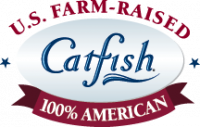Most people dread the question, “What’s for dinner?” Finding recipes, proteins and side dishes for meals can be challenging, especially if you are wanting to adhere to a healthier diet. Heartland Catfish is a nutrient-dense protein to include in your weekly meal rotation. To optimize the benefits of eating catfish, incorporate it in your meals 1-2 times a week, preparing with dry cooking methods and natural cooking oils. Your tastebuds will thank you as Heartland Catfish provides an array of delicious recipes to try out all summer long.
Consume Catfish 1-2 Times a Week
Catfish are low in mercury and contain omega-3 fatty acids. Omega-3 fatty acids are important to consume as they aid in improving brain and heart health, skeletal muscle strength and even gut microbiome. Since the human body does not produce these acids on its own, it is vital to consume foods that do contain them. Catfish is a nutrient-dense, lean protein that is low in calories. This means you are consuming food that is rich in protein and nutrients but relatively low in calories. The standard serving size of U.S. farm-raised catfish contains 105 calories, 2.9 grams of fat, 50 milligrams of sodium and 121% of the daily value of your B-12 vitamins, which helps keep blood and nerve cells healthy. Catfish also contain other nutrients like selenium, phosphorus and potassium which provide more than 20% of the daily recommended values.
Dry Cooking Methods
Preparation of meals is half the battle in maintaining a healthy diet. Deep-frying catfish is one of the most popular ways to cook this protein, but not entirely the healthiest option. To keep your catfish healthy, try dry cooking methods such as grilling, baking and pan-frying. Pan-frying is a popular, healthier option to enjoy fried catfish with lower fat content. There are many delicious and savory recipes that utilize dry cooking methods when preparing catfish.
Natural Vegetable Oils to Cook With
Finding the right oil to cook with is important to enhance the flavor as well as the nutritious value of your meal. The factors to look for when choosing your cooking oil is smoke-point, flavor and nutrients. Using highly processed oil can result in losing important beneficiary qualities during production. For example, vegetable oil is a heavily processed, neutral oil that contains a blend of fats from multiple plant sources such as sunflower, corn and soybeans. This oil is highly processed, which results in the beneficiary qualities being lost during production. Compared to vegetable oil, olive oil is not highly processed, which allows the antioxidants, vitamins and minerals to be retained. The less refined an oil is, the more flavor and nutrients it contains.
Olive oil is frequently used when cooking catfish as it maintains a distinct flavor and lower smoking points. Canola oil is another heart-healthy oil that is better used in high-heat cooking such as frying, as it has a higher smoke point. The smoke point is the temperature at which the oil begins to smoke, representing its resistance to heat. It is important to pay attention to an oil smoke point because if it is lower, you may risk adding a burnt taste to your dish.
Heartland Catfish fits into many diets and lifestyles including keto, pescatarians, and depending on preparation, gluten-free. The assembly of your meal can determine the health level and amount of nutrients received. Check out our recipes for healthy and delectable ways to incorporate more U.S. Farm-Raised Catfish into your diet.
LINKS TO HEALTHY CATFISH RECIPES:
- Easy Blackened Keto Catfish & Broccoli
- Spicy Fish & Olive Spaghetti
- Caribbean Jerk Catfish with Black Bean Salad
- Grilled Catfish with Charred Romaine & Chipotle Dressing
RELATED CONTENT:





